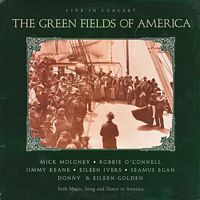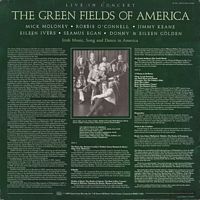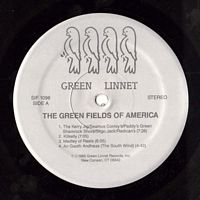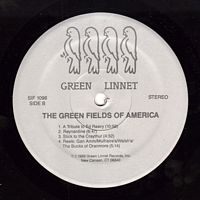
 |


 |
Sleeve Notes
The Green Fields of America is the title of a very old Irish traditional reel, as well as that of one of the most eloquent songs of Irish emigration. It is also the name of a famous Irish American group of traditional musicians, singers and dancers, which has toured the United States on several occasions sponsored by the National Endowment for the Arts.
"The Green Fields of America" captures precisely what the group represents — the persistence of traditional Irish music and dance in the New World. The opportunity America held out, its "green fields," attracted millions of rural Irish emigrants since the earliest times. Between 1848 and 1900 alone, an estimated twelve million Irish emigrated to America. Those emigrants brought with them a rich culture forged through centuries of suffering, struggle and hope. This country provided a new home for this culture, which was revitalized over the years by successive generations of emigrants from the old country. It is also important to realize, however, that these cultural traditions are now as American as they are Irish. New styles and forms developed in the Irish American communities in New York, Chicago, Boston and Philadelphia and have been carried back to the old country for decades. For example, the Bible of Irish musicians on both sides of the Atlantic is Captain Francis O'Neill's MUSIC OF IRELAND, published in 1903 in Chicago, where O'Neill was Commissioner of Fire and Police. Similarly, for a generation, the best makers of the beautiful uilleann pipes of Ireland were the Taylor Brothers of Philadelphia. The brilliant recordings made in New York in the 1920s and '30s of Sligo fiddlers Michael Coleman, James Morrison and Paddy Killoran forever changed the development of Irish fiddle music in Ireland as well as in America. In the large American cities, musicians from widely separated villages in Ireland came together, musicians who would not have met in the old country. A rich cross fertilization of styles and repertoires was the result.
Ireland's sons and daughters still emigrate, as they have for over 200 years, and many of its finest artists are found in American cities. Moreover, there is an exciting new development, one that adds new vigor to the back-and-forth quality of Irish American arts. Brilliant young musicians and dancers of Irish ancestry, born and reared in the United States, have chosen to perform within the Irish tradition but with extensions and innovations that delight those devoted to those arts. When the All-Ireland dance and music competitions are held in Ireland, these young Americans of Irish ancestry are always among the winners. Irish enthusiasts take as much pride in the accomplishments of these young cultural relatives as they do their own.
The personnel of The Green Fields of America has varied since the group was founded in 1977 by Mick Moloney and Washington, D.C. attorney Dick Shea, but the concept is constant: to show in one major gathering some of Irish America's foremost artists — both immigrants and American-born performers.
MICK MOLONEY was born in County Limerick in 1944. He took up the guitar, tenor banjo and mandolin in his 'teens and learned much of his music from older traditional players in neighboring County Clare. He came to America in 1973 and since then has produced over 25 albums of traditional Irish musicians in America. Mick has been named best tenor banjoist in the United States on four occasions by Frets Magazine. He has performed and led workshops at every major festival in the country and played concerts and clubs from coast to coast.
ROBBIE O'CONNELL was born in County Waterford in 1950. He came from a musical family and grew up surrounded by some of Ireland's finest traditional musicians, whose artistry he carries on in his singing. He tours regularly with his uncles The Clancy Brothers, as well as with Mick Moloney and Jimmy Keane. Robbie also has an active solo career.
JIMMY KEANE was born in Chicago in 1960. Growing up with his Gaelic-speaking parents in a household steeped in Irish culture, Jimmy started playing piano accordion at age 11. Since then he has won the All-Ireland Championship six times. He tours with Mick Moloney and Robbie O'Connell in addition to his appearances with The Green Fields of America.
EILEEN IVERS, born of Irish parents in the Bronx in 1965, started playing fiddle at the age of nine. Since then she has won an unprecedented seven All-Ireland titles in a row, culminating in the senior Fiddle Championship in 1984. On this side of the Atlantic she is a prominent musician in the East Coast Irish communities.
DONNY GOLDEN, born in Brooklyn in 1954, started his training in stepdancing early, in New York. He has won many honors, including that of the first American to place in the All-World Stepdance Championship. He has created his own school in New York, where he teaches while performing as often as possible. EILEEN GOLDEN, Donny's sister, is also one of the most well known stepdancers in the United States and has won numerous honors, including the North American title.
SEAMUS EGAN, born of County Mayo parents in Philadelphia in 1969, is a prodigiously talented multi-instrumentalist who has won All-Ireland titles on four instruments — flute, whistle, mandolin and tenor banjo.
The Kerry Jig; Seamus Cooley's; Paddy's Green Shamrock Shore; Sligo Jack & Redican's
We open with a selection of tunes all firmly rooted in the Irish American musical tradition, interspersed with verses from a classic emigration song. We got The Kerry Jig from the playing of the late New York accordion player Charlie Mulvihill. The second jig is named for the noted Galway/Chicago flute player. I first heard Paddy's Green Shamrock Shore sung back in the mid-1960s by Paul Brady, who learned it from the great Derry singer Eddie Butcher. Jimmy Keane composed Sligo Jack after the late, much loved Jack Finan — his friend, barman and musical colleague. We finish with a fine reel composed by the late New York fiddler Larry Redican, with Donny and Eileen stepping it out.
Kilkelly
Washington, D.C. songwriter Peter Jones fashioned this song from emigrant letters written to a family in America from a family in County Mayo in the latter decades of the nineteenth century, a period which saw over ten million people leaving Ireland, most never to return.
Medley of Reels: The Maids of Galway; The Reel of Rio; Coyne's; Return to Miltown; Hunting the Boyne & Return of the Maids
The first tune is a variant created by Jimmy of an older reel of the same name. Mick follows with a reel composed by the late Offaly fiddler Seán Ryan. Seamus learned Coynes during a visit to Miltown Malbay: The same town features in the title of the next tune, which is one of Eileen's current favorites. Jimmy is next with a version of a tune which is a distant cousin of an older reel. The Boyne Hunt. The group goes back into The Maids of Galway to close the set.
An Gaoth Andheas (The South Wind)
The author of this 17th century son was Domhnall Meirgeach Mac Con Mara (Freckled Donald MacNamara). a native of County Mayo. Exiled in Munster, he asks the South Wind to take greetings and blessings from him to his loved ones in Connaught.
A Tribute to Ed Reavy: Fling: Lovely Bannion Jig: Both Meat and Dhrink Hornpipe: The The Fiddler's Wife Reel: The Ceilier Reel: Maudebawn Chapel Reel: The Hunter's House
Ed Reavy, born in Barnagrove in County Cavan in 1899, passed away in January of 1988. He emigrated to Philadelphia in 1910 with his family and settled there, working as a master plumber for most of his life. He left a legacy of beautiful music, which he composed mostly between 1930 and 1970. Many of his compositions have already passed into the Irish musical tradition, making him a household name in Irish music circles. Eugene O'Donnell and I played at his funeral in the church, and Seamus Egan played a lonesome tune of Ed's at the graveside in Drexel Hill, Pennsylvania — an unforgettable and poignant moment on the coldest day of the year. Camden, New Jersey pastor and social activist Father Michael Doyle wrote the poem which-precedes the musical tribute to Ed featuring six of his compositions, concluding with Donny and Eileen dancing to his best known tune The Hunter's House.
Reynardine
There are many eerie old world songs about the enigmatic character Reynardine — half man, half beast. He preys on beautiful women who usually disappear without trace. In this New England version of the song, which I learned from Vermont singer Margaret MacArthur, the "pretty maiden" is fortunate enough to escape with her life.
Stick to the Craythur
A jovial song on the medicinal and spiritual properties of our national illegal elixir which is now, incidentally, more in demand than ever due to the astronomical Irish government tax on the legal variety.
Reels: Gan Ainm; Mulhaire's; Walsh's & The Bucks of Oranmore
The group usually finishes its concerts with these four great reels. The first has no known title; the second is a composition of the great Galway accordion player Martin Mulhaire who now lives in Queens, New York. The third is a distant relation of an older tune called Green Gates, and the last tune, "The Bucks," is one of the great Irish "session tunes" of all time.